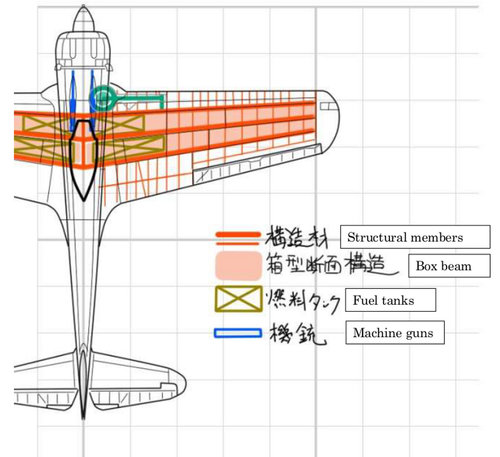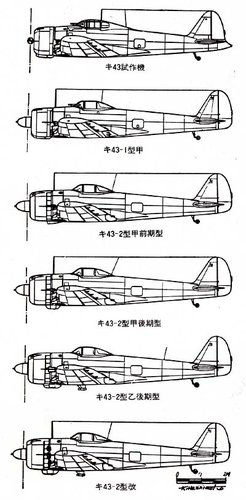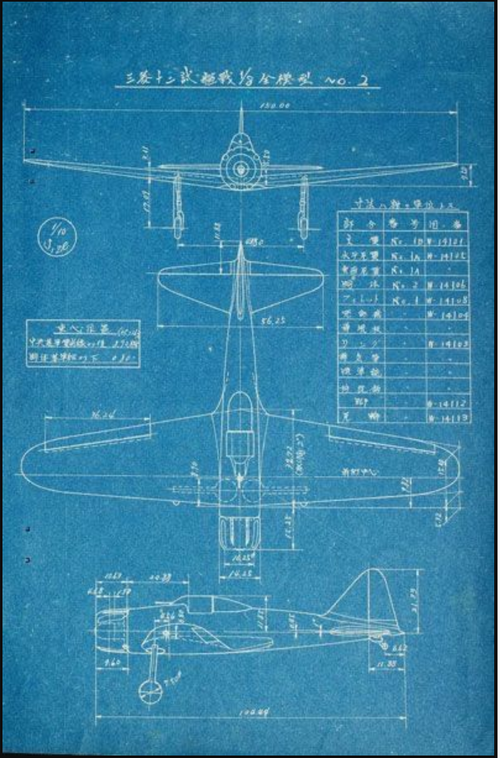You are using an out of date browser. It may not display this or other websites correctly.
You should upgrade or use an alternative browser.
You should upgrade or use an alternative browser.
A6M Zero competition
- Thread starter swallow
- Start date
- Joined
- 21 May 2006
- Messages
- 2,833
- Reaction score
- 1,917
Interesting topic!
For I did not know that the Mitsubishi ‘Zero’ was a competitive design competition.
Nor did I know that Nakajima submitted a design to this requirement!
I have never heard of the Nakajima 12Shi design
Look forward to responses
Regards
Pioneer
For I did not know that the Mitsubishi ‘Zero’ was a competitive design competition.
Nor did I know that Nakajima submitted a design to this requirement!
I have never heard of the Nakajima 12Shi design
Look forward to responses
Regards
Pioneer
blackkite
Don't laugh, don't cry, don't even curse, but.....
- Joined
- 31 May 2007
- Messages
- 8,598
- Reaction score
- 6,849
(Removed link to Osprey book - Osprey may be giving away some ebooks at present but we shouldn’t be linking to entire books on third party websites -Admin)
Last edited by a moderator:
- Joined
- 27 December 2005
- Messages
- 16,925
- Reaction score
- 21,799
Sorry, but linking to downloads of currently-available books is not ok. If there's something relevant to the discussion in the book, maybe post that?
blackkite
Don't laugh, don't cry, don't even curse, but.....
- Joined
- 31 May 2007
- Messages
- 8,598
- Reaction score
- 6,849
Hi T-50-san! Long time no see. How are you?
Ki-43 is Hayabusa.(隼)
http://ktymtskz.my.coocan.jp/J/JP/abu0.htm
http://ktymtskz.my.coocan.jp/J/JP/abu10.htm
http://soyuyo.main.jp/ki43d/ki43-1.html
Ki-43 is Hayabusa.(隼)
http://ktymtskz.my.coocan.jp/J/JP/abu0.htm
http://ktymtskz.my.coocan.jp/J/JP/abu10.htm
http://soyuyo.main.jp/ki43d/ki43-1.html
Attachments
Last edited:
Hill Black kite san I'm still live and kicking!how are you? I'm still enjoying your awesome topics!Hi T-50-san! Long time no see. How are you?
Ki-43 is Hayabusa.(隼)
http://ktymtskz.my.coocan.jp/J/JP/abu0.htm
http://ktymtskz.my.coocan.jp/J/JP/abu10.htm
http://soyuyo.main.jp/ki43d/ki43-1.html
Ki-43 a beautiful light nimble but very deadly plane!Hi T-50-san! Long time no see. How are you?
Ki-43 is Hayabusa.(隼)
http://ktymtskz.my.coocan.jp/J/JP/abu0.htm
http://ktymtskz.my.coocan.jp/J/JP/abu10.htm
http://soyuyo.main.jp/ki43d/ki43-1.html
windswords
ACCESS: Secret
- Joined
- 19 May 2009
- Messages
- 388
- Reaction score
- 207
Not to drag this off-topic but Balckkites diagram of the Ki-43 wing shows why it never could have wing mounted guns like the Zero. Those 3 wing spars and the box beam construction did not allow room for installing a wing gun of any size.
blackkite
Don't laugh, don't cry, don't even curse, but.....
- Joined
- 31 May 2007
- Messages
- 8,598
- Reaction score
- 6,849
Regarding the Hayabusa fighter, bulletproof equipment was superior to zero, at mid altitude it was excellent in movement performance and acceleration performance, and although the armament was poor, it was evaluated by the Allied Forces that it could never be underestimated.
Sorry for off topoic.
Sorry for off topoic.
blackkite
Don't laugh, don't cry, don't even curse, but.....
- Joined
- 31 May 2007
- Messages
- 8,598
- Reaction score
- 6,849
Hayabusa fighters had been fighting such as Spitfire, P-38, P-47, and P-51A/B/C/D even after the latter half of 1944 on the front lines of Burma (Myanmar) and China, and had achieved equal or better results. Especially in the latter part of the war in Burma,Hayabusa fighters unilaterally shot down these new fighters in the first engagement.
These records are "historical facts" that are supported by comparing the battle results and loss records of the Japanese and Allied forces.
As an example, the following records are the actual results and actual damages that are backed up and recorded from the July 2nd, 1943 (July 18th, 1943) to the July 30th, 1944.
Hayabusa surely shot down 135 Allied aircraft in the battle.
1.Lost 83 Hayabusa in the battles.
2.The breakdown of shot down Allied military models were 70 fighters, 32 bombers, and 33 transport aircraft.
3. Allied fighters shot down 61 Hayabusa.
At the time of the entire Burmese aviation battle, Japanese fighters shot down 142 sircraft and Allied fighter shot down 127 aircraft.
The following are the actual battle results and actual damage of a Hayabusa fighter belonging to the 3rd Air Force of the Japanese Army. The period was from August 18, 1944 to August 13, 1945, and the region was Southeast Asia (Burma, French Indochina, Malay, Indonesia, Thailand, etc.).
Hayabusa fighter surely shot down 63 Allied planes (72 allied planes will be surely shot down including 9 Allied unreturned planes that may shot down)
1. 61 Hayabusa lost in battle.
2. The breakdown of Allied aircraft were 14 fighters (or 18 to 19), 32 bombers (or 36 to 37), and 17 transport aircraft.
3. 47 Hayabusa were shot down in battle by Allied fighters. The remaining 14 are due to the guns of the bomber.
Source : Japanese internet site.
These records are "historical facts" that are supported by comparing the battle results and loss records of the Japanese and Allied forces.
As an example, the following records are the actual results and actual damages that are backed up and recorded from the July 2nd, 1943 (July 18th, 1943) to the July 30th, 1944.
Hayabusa surely shot down 135 Allied aircraft in the battle.
1.Lost 83 Hayabusa in the battles.
2.The breakdown of shot down Allied military models were 70 fighters, 32 bombers, and 33 transport aircraft.
3. Allied fighters shot down 61 Hayabusa.
At the time of the entire Burmese aviation battle, Japanese fighters shot down 142 sircraft and Allied fighter shot down 127 aircraft.
The following are the actual battle results and actual damage of a Hayabusa fighter belonging to the 3rd Air Force of the Japanese Army. The period was from August 18, 1944 to August 13, 1945, and the region was Southeast Asia (Burma, French Indochina, Malay, Indonesia, Thailand, etc.).
Hayabusa fighter surely shot down 63 Allied planes (72 allied planes will be surely shot down including 9 Allied unreturned planes that may shot down)
1. 61 Hayabusa lost in battle.
2. The breakdown of Allied aircraft were 14 fighters (or 18 to 19), 32 bombers (or 36 to 37), and 17 transport aircraft.
3. 47 Hayabusa were shot down in battle by Allied fighters. The remaining 14 are due to the guns of the bomber.
Source : Japanese internet site.
Last edited:
The Hayabusa was not so helplessentially against late allied planes at all.Good to hear that Blackkite San! It was much maneuverable than Hellcat and Corsair so if the pilot was trained well he has a good chance to winHayabusa fighters had been fighting such as Spitfire, P-38, P-47, and P-51A/B/C/D even after the latter half of 1944 on the front lines of Burma (Myanmar) and China, and had achieved equal or better results. Especially in the latter part of the war in Burma,Hayabusa fighters unilaterally shot down these new fighters in the first engagement.
These records are "historical facts" that are supported by comparing the battle results and loss records of the Japanese and Allied forces.
As an example, the following records are the actual results and actual damages that are backed up and recorded from the July 2nd, 1943 (July 18th, 1943) to the July 30th, 1944.
Hayabusa surely shot down 135 Allied aircraft in the battle.
1.Lost 83 Hayabusa in the battles.
2.The breakdown of shot down Allied military models were 70 fighters, 32 bombers, and 33 transport aircraft.
3. Allied fighters shot down 61 Hayabusa.
At the time of the entire Burmese aviation battle, Japanese fighters shot down 142 sircraft and Allied fighter shot down 127 aircraft.
The following are the actual battle results and actual damage of a Hayabusa fighter belonging to the 3rd Air Force of the Japanese Army. The period was from August 18, 1944 to August 13, 1945, and the region was Southeast Asia (Burma, French Indochina, Malay, Indonesia, Thailand, etc.).
Hayabusa fighter surely shot down 63 Allied planes (72 allied planes will be surely shot down including 9 Allied unreturned planes that may shot down)
1. 61 Hayabusa lost in battle.
2. The breakdown of Allied aircraft were 14 fighters (or 18 to 19), 32 bombers (or 36 to 37), and 17 transport aircraft.
3. 47 Hayabusa were shot down in battle by Allied fighters. The remaining 14 are due to the guns of the bomber.
Source : Japanese internet site.
nuuumannn
Cannae be ar*ed changing my personal text
- Joined
- 21 October 2011
- Messages
- 276
- Reaction score
- 538
It was much maneuverable than Hellcat and Corsair
As was the Zero. Right until the end of the war, Allied pilots were being warned never to dogfight the Zero.
- Joined
- 26 May 2006
- Messages
- 33,575
- Reaction score
- 13,703
Was that drawing for Mitsubishi Zero or not ?.
Attachments
- Joined
- 21 May 2006
- Messages
- 2,833
- Reaction score
- 1,917
Sorry, I didn't know where else to post this question pertaining to the Mitsubishi A6M, but on this thread......
In a discussion I had with a fellow aeroplane enthusiast yesterday, he made mention that Japan offered Sweden the Mitsubishi A6M as a consequence of Sweden's urgent need for a modern fighter after the United States embargoed it's delivery of Seversky P-35 and Vultee P-66 Vanguard in late 1940.
Is there any truth to this? If so, does anyone, have any supporting documentation to the Japan's proposal/submission?
Regards
Pioneer
In a discussion I had with a fellow aeroplane enthusiast yesterday, he made mention that Japan offered Sweden the Mitsubishi A6M as a consequence of Sweden's urgent need for a modern fighter after the United States embargoed it's delivery of Seversky P-35 and Vultee P-66 Vanguard in late 1940.
Is there any truth to this? If so, does anyone, have any supporting documentation to the Japan's proposal/submission?
Regards
Pioneer
Last edited:
Similar threads
-
-
16 shi specifications for Zero replacement
- Started by Hardrada55
- Replies: 1
-
11-Shi Navy Type 99 Carrier Bomber competition (D3A, D3N)
- Started by swallow
- Replies: 16
-
-



